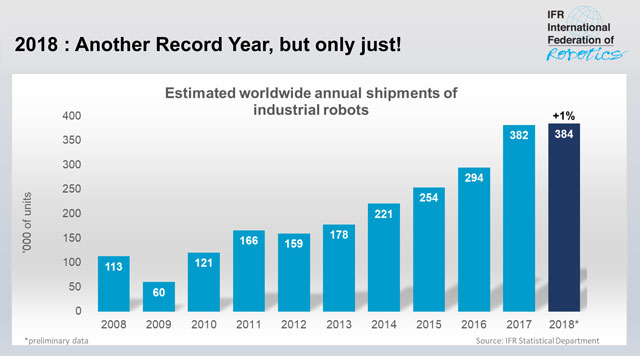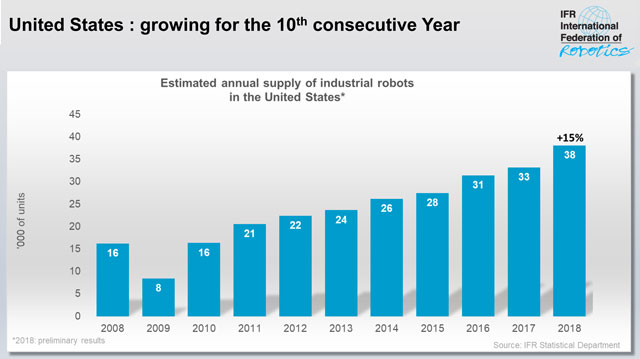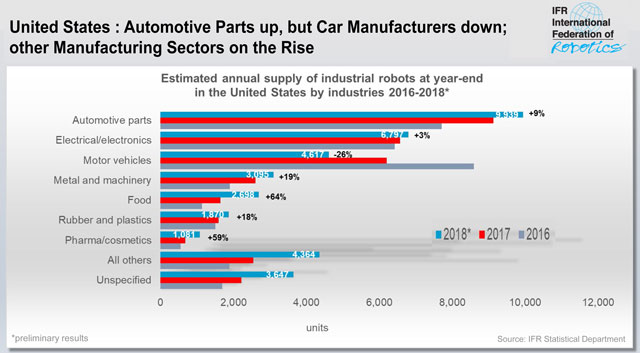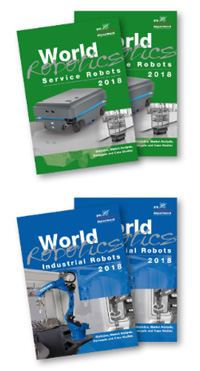
Robohub.org
2018 industrial robot sales barely eke out year-over-year gain
The International Federation of Robotics (IFR), at a press conference here last week, announced preliminary 2018 figures for the industrial sector of the robotics industry. Last year set another record — but just barely. It was only up 1% over 2017. No information was given about service and field robotics.

It’s true that 2017 was a banner year, with a 30% year-over-year gain. So what happened in 2018 to slow that progress?
- China’s auto sales were down for the first time in 28 years — down 6% — and U.S. sales were flat. Globally, car sales were down 3%. This caused the automotive sector of the robotics industry to be down by 15% in China and 26% in the US.
- Global smartphones were also down 5%, which caused the electronics sector of the robotics industry to decline by 8%.
- According to Henry Sun, director of strategy at MINO Automotive Equipment China, “Consumers appear to be taking a ‘wait and see’ approach, as there is some uncertainty with rumors of policies affecting auto purchases, as well as uncertainty surrounding the general economy.”
- On the bright side, he also said: “EV manufacturing is a big stimulus for automotive robots. Installation of new production lines and plants and re-tooling of existing ones — such as battery and e-motor assembly — and expanding the EV portfolio is fundamental to many OEMs’ long-term strategies. China is the global focal point for EVs, and significant investments will be made [over the next many years].”
Although robot sales were down in Asia, they were up 6% in the Americas and 7% in in the EU. In fact, the U.S. had a really good year, up 15% from 2017, while both Canada and Mexico were down 15% and 13%, respectively.

Double-digit growth was seen in other types of manufacturing, including the food and beverage, pharmaceuticals, plastics, and metals sectors, reported the IFR.

IFR spokesman Steven Wyatt recaps 2018
Challenges on the horizon
Looking forward, the auto industry is likely to be more volatile, particularly as it transitions from the combustion engine to EVs (electric vehicles) and self-driving vehicles begin to come to market.
Speakers in the IFR CEO Roundtable, held at Automate in conjunction with the IFR’s announcement of its 2018 preliminary figures, stressed that finding skilled workers continues to be a primary concern.
Another challenge is that robot makers need to provide operating software for their products that is easy to learn, doesn’t require a legacy programmer, and is intuitive to use.
“The U.S. government is not doing a lot to strengthen U.S. competitiveness in robotics,” said Robert Atkinson, president of ITIF (Information Technology and Innovation Foundation). “The National Science Foundation does have a national robotics initiative to support research, but it is largely under-funded, not tied enough to industry needs, and is focused only on robots that complement, rather than replace workers.”
Byron Clayton, CEO of ARM (the Advanced Robotics for Manufacturing Institute), said: “The shortage of skilled workers is driving changes in how potential and existing employees are recruited and trained. Unskilled workers must be taught to operate, program, and maintain robots and related technologies.”
Introduction of machine learning
Junji Tsuda, IFR president and director chairman of the board of Yaskawa, discussed the role AI will play in the next few years in the robotics industry.
“AI is the great accelerator to enhance the capability of sensors and analysis of data,” he said. “AI technology application has already started, [but] we need system integrators‘ involvement to accelerate the process. … There are two aspects of AI application: one for engineering, and the other for stable operations.”
- For engineering, the digital twin will be the key method, and machine learning with a simulator will be the biggest contributor.
- For stable operations, sensors will be the key factors to control quality of manufacturing and to keep machines running without unpredictable failures.
About the IFR
 The IFR is composed of all of the national robot associations around the world, major R&D institutes, and big robot suppliers and integrators.
The IFR is composed of all of the national robot associations around the world, major R&D institutes, and big robot suppliers and integrators.
It is the primary resource for worldwide data on the use of robotics and produces two annual reports covering sales for the previous calendar year: World Robotics Industrial Robots and World Robotics Service Robots. The 2019 reports covering 2018 activity will be available in late September or October at a cost of around $2,250 for the set.
The IFR also sponsors the annual International Symposium on Robotics held this year in conjunction with Automate. It also co-sponsors the IERA Awards, which recognize the entrepreneurial commercialization of ideas into actual products.


